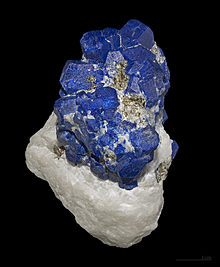
Back Lazurita AST Lazurit Azerbaijani Лазурыт Byelorussian Лазурит Bulgarian Latzurita Catalan Lazurit Czech Лазурит CV Lazurit Danish Lasurit German Lazurito Esperanto
| Lazurite | |
|---|---|
 Lazurite, Ladjuar Medam (Lajur Madan; Lapis-lazuli Mine), Sar-e-Sang District, Koksha Valley (Kokscha; Kokcha), Badakhshan (Badakshan; Badahsan) Province, Afghanistan | |
| General | |
| Category | Tectosilicate |
| Formula (repeating unit) | (Na,Ca)8[(S,Cl,SO4,OH)2|(Al6Si6O24)] |
| IMA symbol | Lzr[1] |
| Strunz classification | 9.FB.10 |
| Crystal system | Isometric |
| Crystal class | Hextetrahedral (43m) H-M symbol: (4 3m) |
| Space group | P43n |
| Unit cell | a = 9.09 Å; Z = 2 |
| Identification | |
| Color | Deep blue, azure, violet-blue, greenish blue |
| Crystal habit | Crystals occur as dodecahedra, or rarely cubes; granular, disseminated, or massive |
| Cleavage | Imperfect on {110} |
| Fracture | Uneven |
| Tenacity | Brittle |
| Mohs scale hardness | 5–5.5 |
| Luster | Vitreous |
| Diaphaneity | Translucent to opaque |
| Specific gravity | 2.38–2.45 |
| Optical properties | Isotropic; anomalously anisotropic |
| Refractive index | 1.502–1.522 |
| Fusibility | 3.5 |
| Solubility | Soluble in HCl |
| References | [2][3][4][5][6] |
Lazurite, old name Azure spar[7]: 14 is a tectosilicate mineral with sulfate, sulfur and chloride with formula (Na,Ca)8[(S,Cl,SO4,OH)2|(Al6Si6O24)]. It is a feldspathoid and a member of the sodalite group. Lazurite crystallizes in the isometric system although well‐formed crystals are rare. It is usually massive and forms the bulk of the gemstone lapis lazuli.
- ^ Warr, L.N. (2021). "IMA–CNMNC approved mineral symbols". Mineralogical Magazine. 85 (3): 291–320. Bibcode:2021MinM...85..291W. doi:10.1180/mgm.2021.43. S2CID 235729616.
- ^ Handbook of Mineralogy
- ^ Mindat with location data
- ^ Webmineral data
- ^ Hurlbut, Cornelius S. and Klein, Cornelis, 1985, Manual of Mineralogy, 20th ed., Wiley, p. 459 ISBN 0-471-80580-7
- ^ "Mineralogical Society of America" (PDF). Archived from the original (PDF) on 2016-03-03. Retrieved 2011-03-08.
- ^ Krivovichev V. G. Mineralogical glossary. Scientific editor A. G. Bulakh. — St.Petersburg: St.Petersburg Univ. Publ. House. 2009. — 556 p. — ISBN 978-5-288-04863-0. (in Russian)